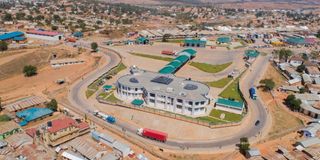Prime
Why border towns offer both opportunities and challenges

The one-stop border post in the town of Tunduma on Tanzania’s border with Zambia. PHOTO | FILE
What you need to know:
- The government of Tanzania has in the past taken steps to improve matters. For example, the Tunduma-Nakonde One Stop Border Post (OSBP), established in 2019, was intended to streamline operations, but truckers continue to face substantial waiting times on the Tanzanian side due to various factors.
A few years ago, a colleague who had foresight suggested that there were all the reasons to acquire land at any of the towns between Tanzania and its neighbours. His argument was that crossing the border with goods destined to neighbouring countries, especially if those countries are land locked, was not easy and that there is all the likelihood of transit traffic spending days or weeks at the border.
This was an opportunity for investing in real estate in such border towns as Tunduma, in areas like parking yards for trucks, warehouses for goods, lodges for drivers and of course, all kinds of eateries and hospitality industries.
This sounded a plausible hypothesis, given that as of August 2024, over 70 percent of the cargo passing through the Port of Dar es Salaam to neighbouring countries comes from Tanzania via the Tunduma border. Those who invested in strategically-located land at border towns are possibly reaping big.
Border towns have their unique problems. The drafters of the revised Tanzanian Human Settlements Policy 2000, found it prudent to include border towns among the 29 policy issues covering a wide range of problems, that need addressing. Issue number 3.24 is titled: “Small islands, border towns and conservation areas”.
In the Draft Policy it is noted that: “Border towns include urban/rural settlements built on boundary between Tanzania and neighbouring countries. These are areas where social, political and cultural geography cutting across countries often overlap.
Apart from the few official exit and entry points, international boundaries around such towns are often porous, making it difficult to effectively control movements of people and goods in human settlements lying on international boundaries.
In addition to the weak security and unregulated socio-economic activities, there are also challenges related to uncoordinated and unregulated land use planning, development and management in international border towns”. So, border towns pose special land use and management problems.
It was recently reported in the media that truck drivers had blocked the Tunduma-Mbeya Highway in the Chapwa areas wanting tax authorities from both Zambia (ZRA) and Tanzania (TRA) to meet them and address their grievances related to the long delays they are facing at border crossings, which greatly inconveniences them and increases their travel costs.
Truck drivers have long been protesting against alleged inefficiencies and congestion. The drivers are seeking improved border operations and infrastructure to reduce long waiting times. The Tunduma border post, which serves as a key gateway for goods moving between Tanzania, Zambia, DRC and other African countries, has been experiencing considerable delays.
The government of Tanzania has in the past taken steps to improve matters. For example, the Tunduma-Nakonde One Stop Border Post (OSBP), established in 2019, was intended to streamline operations, but truckers continue to face substantial waiting times on the Tanzanian side due to various factors.
The drivers' protest highlights the ongoing challenges in managing cross-border trade and the need for better infrastructure and efficient procedures at the border. The Central Corridor, which includes the Tunduma border, is a vital route for trade within East Africa and disruptions at this point can have significant economic consequences.
Border town have other problems besides those related to crossing delays. These include security threats, inadequate infrastructure and issues related to cross-border trade and movement. Lack of proper infrastructure, including customs harmonisation and communication technology, hinders efficient border management.
Additionally, porous borders facilitate the movement of people, goods and potentially diseases, impacting both security and public health. Language barriers and policy differences between neighbours do many times, exacerbate problems.
The latest protest by truck drivers against delays is one of many that have been taking place again and again. Delays, such as those related to tax matters are difficult to explain given the developments in technology and the fact that cargo is well documented and well inspected before it is loaded on ships, after it has been off-loaded, when it is loaded on trucks, before the trucks start their journey and at various check-points on the route. It would appear that when the trucks arrive at the border, the whole process starts anew, leading to delays lasting days or weeks.
However, steps to increase efficiency at border towns should investigate the incentives not to be efficient, since there is a potential for economic benefits from cargo trucks staying long at border posts. This could be the case on both sides of the border.
To increase efficiency at border crossings, there is need to make the economies of these border towns to be less dependent on the slowness of activities related to border crossing.
Border towns could for example be encouraged to develop into tourist, cultural and entertainment centres, based on the unique cultural and geographical features of the border region, attracting visitors from both sides of the border. Local trade, between neighbours could be encouraged based on opportunities existing on both sides.
Besides, border towns should have joint governance institutions to harmonise policies and processes, as well as land use planning matters on both sides of the border.
It may sound contradictory, but plans to improve efficiency for crossing border towns should investigate the incentives NOT to be efficient which in part, may be rooted in protecting the status quo.





